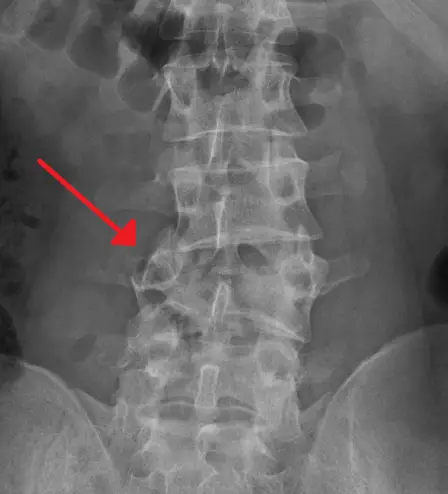A lumbar fracture is a break or crack in one of the five vertebrae located in the lower back, between the thoracic spine and the sacrum. These fractures can be caused by major trauma or minor injuries, such as falls or car accidents.
They can also occur spontaneously in patients with diseases that weaken the bones, such as osteoporosis or cancer. In this article, we will discuss the definition and healing process of low back fractures.
What is a lumbar fracture?
A lumbar fracture is a break in one of the bones in the lower part of the spine. The lower part of the spine includes the last five vertebrae, numbered L1 to L5.
These bones are protected by flexible discs of cartilage and are held together by a network of ligaments and muscles. A lumbar fracture can occur following a violent shock, such as a car accident or a fall from a great height.
La bone loss can also be caused by osteoporosis, a disease that decreases bone strength.
Symptoms of a lumbar fracture include pain, swelling, and bruising in the lower back. In some cases, the person may also experience numbness or tingling in the legs.
If you think you have a lumbar fracture, it is important to consult a doctor immediately. A doctor will be able to confirm the diagnosis with an X-ray or MRI and develop a treatment plan.
Treatment may involve wearing a splint or a cast, and in some cases surgery may be required. With proper treatment, most people with lumbar fractures recover fully.
Anatomy of spine and lumbar vertebrae
La spine is a column of bones called vertebrae that protects the spinal cord. The vertebrae are stacked on top of each other and connected by ligaments, muscles and tendons.
The spine has four main regions: the cervical spine, thoracic spine, lumbar spine and the sacred column. Each region has a different number of vertebrae.
The cervical spine has seven vertebrae, the thoracic spine twelve vertebrae, the lumbar spine five vertebrae and column sacral five vertebrae.
The lumbar spine is located in the lower back and extends from the bottom of the rib cage to the pelvis. It supports most of the body's weight and is responsible for much of the body's movements.
The causes of fracture
The most common cause of lumbar fracture is osteoporosis, a disease that weakens bones and makes them more likely to break.
To learn more about osteoporosis, see the following article.
People with osteoporosis often suffer from compression fractures, which occur when the bones collapse due to the weakening of bone mass.
In some cases, a lumbar fracture can also be caused by a tumor or infection.
There are several types of lumbar fractures, and each one requires different treatment.
The compression fracture
The most common type lumbar fracture is the compression fracture, which is usually treated with rest, ice, and painkillers. A compression fracture occurs when the vertebrae, or bones, of the spine collapse.
This can be due to an injury, such as a fall, or weakening of the bones, as is often the case with osteoporosis.
A fracture by lumbar compression usually affects the lower back and can cause pain, difficulty moving and loss of height. In severe cases, the collapsed vertebra may press on the spinal cord, leading to paralysis.
Lateral process fractures and pars fractures
Two other types of lumbar fractures are the fractures of the lateral process and the fractures of the pars.
Lateral spinous fractures are fractures of the bony protrusions that run down the sides of the vertebrae, while pars fractures are fractures of a small piece of bone that connects the vertebrae.
Both types of fractures can be treated with rest, ice, water and anti-inflammatory drugs. In some cases, surgery may be necessary.
Healing process and time
Despite its strength, the spine is susceptible to injury and disease. When a vertebra is damaged, it can cause immense pain and disability.
Fortunately, the human body is an amazing machine, and its ability to heal is one of its most impressive characteristics.
When a bone is broken, the body begins a complex process of repair. First of all, the blood vessels of the area are damaged, causing bleeding.
This cleans the wound and provide essential nutrients and oxygen to healing. Then special cells called fibroblasts move into the area and start laying down new collagen fibers. These fibers provide support and strength to healing bones.
Eventually, new blood vessels begin to grow and the wound closes. This whole process can take weeks or even months, but it is a testament to the human body's ability to heal itself.
Healing time
The healing time of a lumbar fracture depends on the location and severity of the injury. In most cases, the healing process takes six to eight weeks.
However, some people may experience persistent pain or other complications, and their recovery may take longer.
Treatment: How to treat a lumbar fracture?
There’s plenty of lumbar bone fractures can be treated in several ways, depending on the severity of the injury. For relatively minor fractures, a simple brace may be sufficient to stabilize the spine and allow healing.
More severe fractures may require surgical intervention to implant rods or other devices to stabilize the spine.
In some cases, artificial discs may also be used to replace the discs damaged vertebral. Either way, however, it's important to maintain a healthy lifestyle and avoid activities that could put undue strain on your back.
Steps for the treatment of a lumbar fracture
The treatment of a lumbar fracture involves the following steps:
- The first step in the healing process is to immobilize the spine to allow the vertebrae to heal properly. This can be done using a orthosis, a cast or a splint.
- Once the column has stabilized, the next step is to reduce inflammation and pain. This is usually done in combination with painkillers and physical therapy.
- La physiotherapy (physiotherapy) helps stretch and strengthen the muscles around the spine, which can help the healing process.
However, with care and appropriate rehabilitation, most people can return to a normal life after a lumbar fracture. The fractures of the Lumbar spine are relatively common, but fortunately most heal well with time and proper care.
The most effective rehabilitation methods
A lumbar fracture is a serious injury that can lead to significant pain and mobility problems. However, with proper rehabilitation, patients can regain their strength and range of motion.
There are several rehabilitation methods that can be used to treat a low back fracture.
La physiotherapy (physiotherapy) is often used to help patients regain strength and range of motion. Core stability and leg strengthening exercises are often prescribed.
Also, patients can learn how to lift and carry objects properly to avoid putting too much strain on their backs. Massage therapy can also be helpful in relieving pain and improving flexibility.
La aquatic therapy is another option that can be very beneficial for patients suffering from a lumbar fracture. The buoyancy of the water helps take the weight off the back and allows for a greater range of motion.
With the help of rehabilitation, patients suffering from a lumbar fracture can recover completely.
Lumbar fracture in the elderly
La lumbar fracture is a type of broken bone that occurs in the lower part of the spine. This type of injury is more common in older people, especially those with osteoporosis or other bone-weakening conditions.
Therefore, they are at an increased risk of sustaining a lumbar fracture. Furthermore, the process healing may be slower in older people, and the risk of complications such as infection is higher.
A lumbar fracture can also cause nerve damage, which can lead to pain, numbness, or paralysis.
For these reasons, it is important that older people consult a doctor if they suffer a trauma in the lower back. With prompt treatment, the chances of a full recovery are greatly increased.


